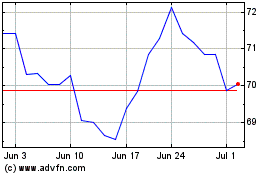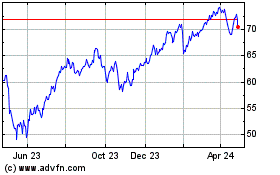By Leslie Scism
When Steven A. Kandarian was named chief executive officer of
MetLife Inc. back in 2011, it looked like smooth sailing ahead. The
global financial crisis was over.
The problem was, the bond market never got the memo. Interest
rates fell to never-before-seen levels, causing headaches for
MetLife and other life insurers. The low yields depressed their
interest income, a big part of their bottom line.
What's more, the Dodd-Frank regulatory overhaul ensnared
MetLife. A new panel created by that law designated the company
"systemically important" and subject to heightened oversight. Mr.
Kandarian successfully sued the U.S. government to escape the
designation.
As low rates persisted, in 2017 he spun off a fifth of the
company -- its historic core selling life insurance to American
families -- in part because the products required so much
capital.
The 67-year-old executive is leaving MetLife April 30. He stayed
two years past the insurer's customary retirement age to complete
the spinoff and get succession underway. One of his deputies,
Michel Khalaf, is succeeding him.
From his 56th-floor conference room in the MetLife building
above Grand Central station in midtown Manhattan, Mr. Kandarian
spoke about his eight years at the helm. Here, condensed and edited
excerpts from that conversation:
WSJ: What decision was tougher: suing the U.S. government to
challenge MetLife's designation as a systemically important
financial institution, or spinning off the individual-focused
operations symbolized by MetLife's long-time Snoopy logo into
Brighthouse Financial Inc.?
Mr. Kandarian: The spinoff of Brighthouse was the more difficult
decision. It was an emotional one. There was a lot of attachment to
that business in our company, with our employees, former employees,
customers and so on. The business dated back to 1868.
The spinoff enables our shareholders and investors in general to
make a choice on both components of our business. The U.S. retail
business has a different dynamic than the rest of our U.S. business
focused on institutional clients and our international
businesses.
The SIFI decision was more straightforward. In our view, it was
an existential decision to our company: If we were designated, and
if the Federal Reserve wrote capital rules for enhanced capital and
regulation that put us on an unlevel playing field, it would make
it difficult for us to remain as one company. We would have to
ultimately give serious consideration to breaking up the company --
and for no good reason, we felt.
WSJ: Are you saying that divestitures beyond the Brighthouse
spinoff might have occurred?
Mr. Kandarian: Brighthouse was 20% of the company. You would
have to shrink the business significantly to get under whatever
level FSOC felt hit their screen. It would have been a significant
deconstruction of the company, beyond just the U.S. retail
business.
WSJ: As it turned out, after challenging your designation by the
Financial Stability Oversight Council, Donald Trump was elected
president and began a rollback of Dodd-Frank. Two peers -- American
International Group Inc. and Prudential Financial Inc. -- were
"de-designated" thanks partly to Trump appointees to FSOC. Do you
have second thoughts about the amount of money and management time
you spent on the effort?
Mr. Kandarian: We felt that under Dodd-Frank we were not
systemically important by the definition of the law, which is
basically: Would material financial distress of MetLife pose a
threat to the financial stability of the U.S.?
AIG and GE [ General Electric Co., another SIFI] dramatically
changed their businesses, and I think that was a major factor in
their de-designations. But Prudential did not. I don't think
Prudential would have been de-designated had we not contested our
designation in court and won.
WSJ: In other words, you helped a major rival?
Mr. Kandarian: We brought our case forward on behalf of our
customers, our shareholders and employees of MetLife, and
Prudential did benefit from that. We are still waiting for the
thank-you letter from Prudential.
WSJ: You walked a fine line in pushing your case against the
government and not being seen as too antagonistic. It has been
clear that the SIFI designation rankled you. Talk about that.
Mr. Kandarian: I want to be careful here. But I've been thinking
about this for a while and want to lay it out.
The federal financial regulators came under a great deal of
scrutiny soon after the financial crisis broke out for having
failed as regulators in certain cases....I think the SIFI
designations for ourselves and Prudential were largely driven by
the need of these regulators to restore their reputations and
rebuild their standing in certain circles in Washington. It was
more a political decision than an economic one.
We have an interest in an appropriately rigorous regulatory
regime for our industry. We don't have in interest in gratuitous
regulation or capital charges that are well beyond what is
necessary for a solvent system, or a regulatory regime that puts
companies on unlevel playing fields that make it difficult of
impossible to compete. That is what the fight was about.
WSJ: What do you want to be remembered for from your tenure?
Mr. Kandarian: I think probably central to my tenure of CEO is
the de-risking of our company.
When I was chief investment officer we de risked the asset side
of our balance sheet prior to the financial crisis. We sold Peter
Cooper Stuyvesant Town residential complex in New York City for
$5.4 billion in 2006. That asset at that point comprised roughly
half of our real-estate equity portfolio. I felt that was a
too-concentrated position.
We also sold down the riskiest portion of our subprime
mortgages. And we sold approximately $8 billion of credit assets
that we felt would be most vulnerable in a consumer-led
recession.
I focused a great deal on the liability side after becoming CEO.
We exited some products entirely like long-term-care insurance, and
reconfigured others to make them less capital intensive and less
sensitive to assets rolling off our balance sheet and perhaps
having to be reinvested at lower rates in the future.
WSJ: MetLife has committed to large share buybacks with its
excess capital. It seems every day there is more criticism of
buybacks. What can you say to people in this camp who think you are
doing something wrong?
Mr. Kandarian: Some people have set this up as an either/or:
Either you provide for your employees or you do shareholder
repurchases. We do both. We provide health benefits to all of our
employees. We provide sick leave to all of our employees. We have a
$15 minimum wage. Everybody gets $75,000 or more of life insurance.
And we provide a traditional pension to all of our employees.
At the same time we need to take care of those who provide us
capital to run this business. Many of those are just ordinary
people who are investing their retirement funds through
institutional investors.
WSJ: MetLife shares have underperformed other big insurers
during the period you were CEO. Anything you wish you had done
differently?
Mr. Kandarian: It takes time to turn a big ship like MetLife.
I'll give you one example. Sales that were made more than three
years years ago represent 85% of our current bottom line. Because
of the long-term nature of our liabilities, they stay with you for
many, many years. In some cases, for many decades.
We addressed that by spinning off Brighthouse to some degree.
But we still retain a significant number of liabilities related to
our U.S. retail business.
We could have pursued shorter-term actions that may have driven
up near-term earnings but could have exposed the company to losses
in the future.
We know that to get better stock performance, we have to deliver
clean quarters, show we can grow profitability and return capital
to our shareholders when we can't use the capital more
profitably.
WSJ: What's next? Will you run another company?
Mr. Kandarian: It is possible if I do that it would be with a
privately held company.
I think the public company arena has become more difficult to
operate in. The short-term nature of how investors look at things
is one issue, and there are a lot of things today that CEOs didn't
have to focus on as much in the past.
There are now roughly half as many public companies as two
decades ago. That is an unfortunate statistic from the point of
view of providing investment opportunities for ordinary Americans
as they prepare for retirement. The private markets are less
accessible to them than the public markets and the public markets
are shrinking. So that's a regrettable consequence of short-term
pressure on public companies.
(END) Dow Jones Newswires
April 25, 2019 05:44 ET (09:44 GMT)
Copyright (c) 2019 Dow Jones & Company, Inc.
MetLife (NYSE:MET)
Historical Stock Chart
From Aug 2024 to Sep 2024

MetLife (NYSE:MET)
Historical Stock Chart
From Sep 2023 to Sep 2024
